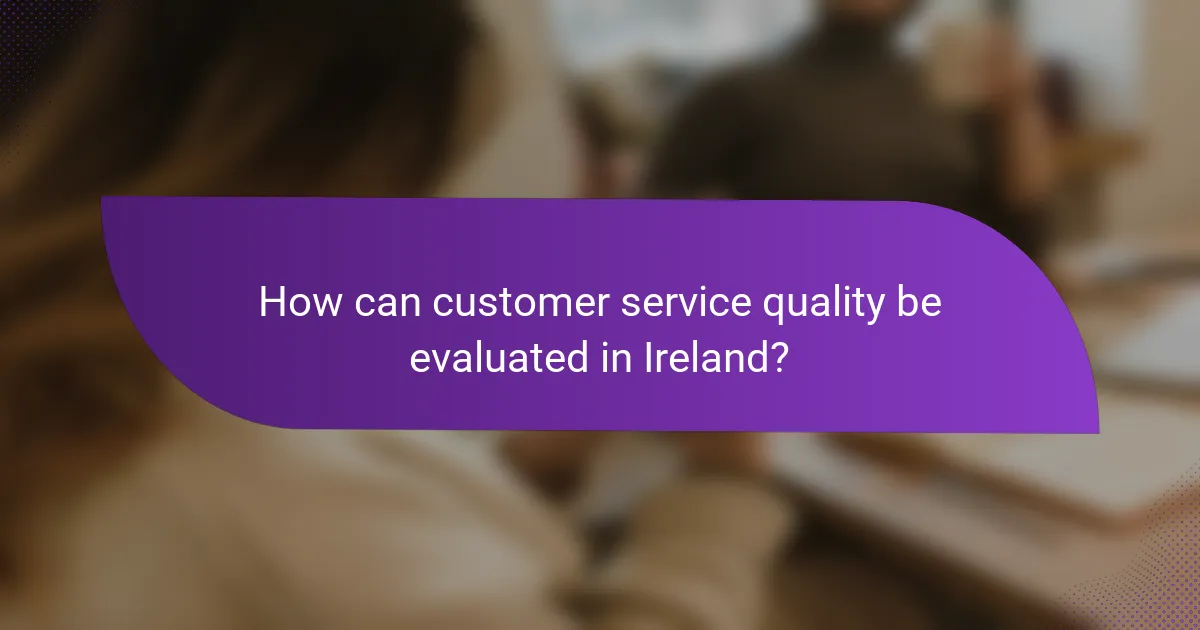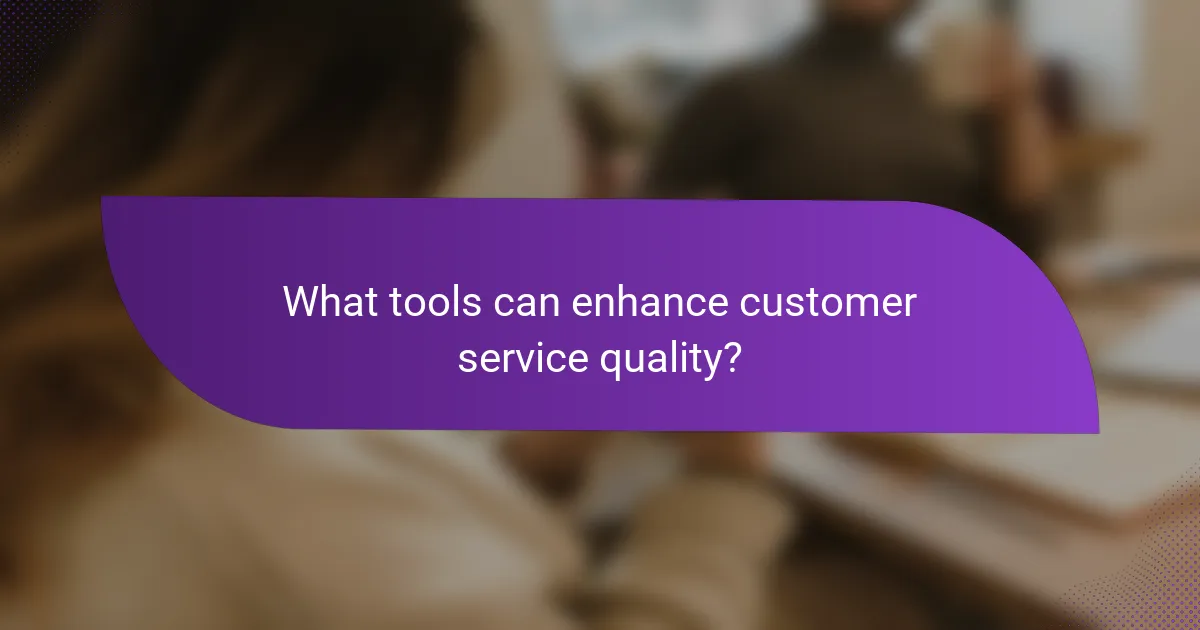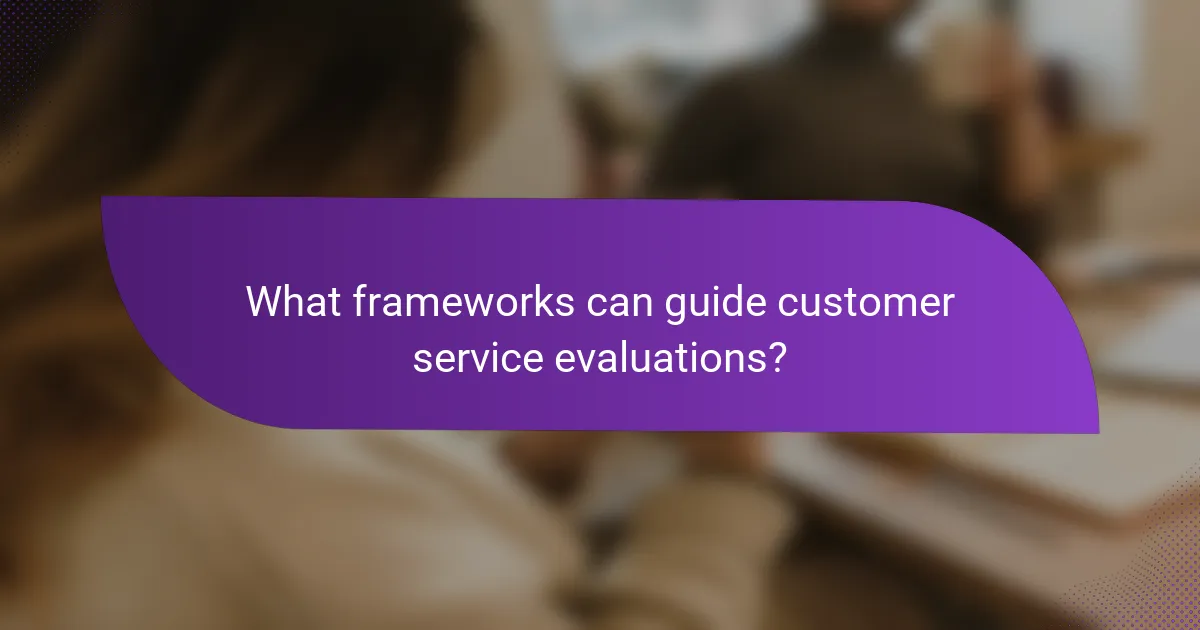Customer service quality is essential for business success, particularly in Ireland, where various metrics can be employed to gauge user satisfaction and operational efficiency. By leveraging effective tools and software, businesses can streamline processes, manage inquiries, and gather feedback, ultimately enhancing the customer experience. High user satisfaction not only fosters customer loyalty but also positively impacts profitability and brand reputation.

How can customer service quality be evaluated in Ireland?
Customer service quality in Ireland can be evaluated using several key metrics that reflect user satisfaction and operational efficiency. These metrics help businesses understand customer perceptions and improve service delivery.
Net Promoter Score (NPS)
Net Promoter Score (NPS) measures customer loyalty by asking how likely customers are to recommend a service to others. Responses are typically scored on a scale from 0 to 10, allowing businesses to categorize customers as promoters, passives, or detractors.
A high NPS indicates strong customer loyalty, while a low score suggests areas needing improvement. Companies in Ireland often aim for an NPS above 30, which is considered good in many industries.
Customer Satisfaction Score (CSAT)
Customer Satisfaction Score (CSAT) gauges how satisfied customers are with a specific interaction or overall service. Typically measured through a short survey immediately following a service encounter, it uses a scale from 1 to 5 or 1 to 10.
In Ireland, a CSAT score above 80% is generally viewed as excellent. Businesses should regularly analyze CSAT feedback to identify trends and areas for enhancement.
First Response Time (FRT)
First Response Time (FRT) measures the time taken for a customer to receive an initial reply after reaching out for support. A shorter FRT often correlates with higher customer satisfaction, as customers appreciate timely assistance.
In Ireland, aiming for an FRT of under 1 hour for email inquiries and under 5 minutes for live chat can significantly boost customer perceptions of service quality.
Customer Effort Score (CES)
Customer Effort Score (CES) assesses how easy it is for customers to resolve their issues. Customers rate their experience on a scale, typically from 1 to 7, with lower scores indicating higher effort.
Reducing customer effort is crucial; businesses in Ireland should strive for a CES that reflects a seamless experience, ideally below 3. This can involve simplifying processes and improving self-service options.
Service Level Agreements (SLAs)
Service Level Agreements (SLAs) are formal agreements that outline expected service levels between a service provider and customers. They define key performance indicators, including response times and resolution times.
In Ireland, establishing clear SLAs helps manage customer expectations and provides a framework for accountability. Regularly reviewing SLAs ensures they remain relevant and aligned with customer needs.

What tools can enhance customer service quality?
Several tools can significantly improve customer service quality by streamlining processes and enhancing user satisfaction. Utilizing the right software can help manage inquiries, integrate customer relationship management (CRM), and gather valuable feedback.
Zendesk for ticket management
Zendesk is a robust platform designed for efficient ticket management, allowing customer service teams to track, prioritize, and resolve customer issues seamlessly. It provides a centralized dashboard where agents can view all incoming requests, ensuring no inquiry goes unanswered.
Key features include automated ticket routing, response templates, and performance analytics. This helps teams maintain high service levels and respond to customer needs promptly, often within a few hours.
Freshdesk for multi-channel support
Freshdesk excels in providing multi-channel support, enabling businesses to engage customers across various platforms such as email, chat, and social media. This flexibility allows customers to reach out through their preferred channels, enhancing their overall experience.
With features like a unified inbox and automated responses, Freshdesk helps streamline communication and ensures that customer inquiries are addressed quickly. This can lead to improved satisfaction rates, as customers appreciate timely and accessible support.
HubSpot for CRM integration
HubSpot offers a comprehensive CRM solution that integrates customer service functionalities, allowing teams to manage customer relationships effectively. This integration provides a 360-degree view of customer interactions, which is crucial for personalized service.
Utilizing HubSpot can help track customer history, preferences, and feedback, enabling agents to tailor their responses. This level of personalization can significantly enhance customer satisfaction and loyalty.
SurveyMonkey for feedback collection
SurveyMonkey is a powerful tool for collecting customer feedback, which is essential for evaluating service quality. By creating surveys that target specific aspects of the customer experience, businesses can gather actionable insights.
Using SurveyMonkey, companies can easily distribute surveys via email or social media and analyze responses to identify trends and areas for improvement. Regular feedback collection can help maintain high service standards and adapt to changing customer needs.

How does user satisfaction impact business performance?
User satisfaction significantly influences business performance by driving customer loyalty and enhancing overall profitability. Satisfied customers are more likely to return, recommend the business to others, and contribute to a positive brand image.
Increased customer retention
High user satisfaction leads to increased customer retention, as happy customers are less likely to switch to competitors. Retaining existing customers is often more cost-effective than acquiring new ones, with studies suggesting that it can be five to twenty-five times cheaper.
To boost retention, businesses should regularly gather feedback and address concerns promptly. Implementing loyalty programs can also encourage repeat purchases and strengthen customer relationships.
Higher revenue growth
When customers are satisfied, they tend to spend more, contributing to higher revenue growth. Satisfied customers often make larger purchases and are more willing to try new products or services offered by the business.
To capitalize on this, companies should focus on enhancing the customer experience, such as providing personalized services or special promotions. Regularly analyzing sales data can help identify trends and opportunities for upselling or cross-selling.
Improved brand reputation
User satisfaction plays a crucial role in shaping a brand’s reputation. Positive experiences lead to favorable reviews and word-of-mouth referrals, which can significantly enhance a company’s public image.
To maintain a strong reputation, businesses should actively manage their online presence and respond to customer feedback. Engaging with customers on social media and addressing complaints transparently can help build trust and credibility.
Enhanced employee morale
High levels of user satisfaction can lead to enhanced employee morale. When employees see their efforts resulting in happy customers, it boosts their motivation and job satisfaction.
To foster this environment, companies should recognize and reward employees for their contributions to customer satisfaction. Providing training and resources to help staff meet customer needs can also improve their engagement and performance.

What are the key metrics for measuring user satisfaction?
Key metrics for measuring user satisfaction include Customer Satisfaction Score (CSAT), Net Promoter Score (NPS), and Customer Effort Score (CES). These metrics provide insights into how customers perceive their interactions with a business and help identify areas for improvement.
Customer Satisfaction Score (CSAT)
Customer Satisfaction Score (CSAT) measures how satisfied customers are with a specific interaction or overall experience. Typically, customers rate their satisfaction on a scale from 1 to 5 or 1 to 10, allowing businesses to quantify satisfaction levels.
To calculate CSAT, divide the number of satisfied customers (those who rated 4 or 5 on a 5-point scale) by the total number of respondents, then multiply by 100 to get a percentage. A CSAT score above 80% is generally considered good, while scores below 60% may indicate issues.
Net Promoter Score (NPS)
Net Promoter Score (NPS) gauges customer loyalty by asking how likely customers are to recommend a company to others on a scale from 0 to 10. Respondents are categorized into promoters (9-10), passives (7-8), and detractors (0-6).
To calculate NPS, subtract the percentage of detractors from the percentage of promoters. A positive NPS (above 0) indicates more promoters than detractors, while a score above 50 is considered excellent. Regularly tracking NPS can help businesses understand customer sentiment and loyalty trends.
Customer Effort Score (CES)
Customer Effort Score (CES) measures how easy or difficult it is for customers to complete a task, such as resolving an issue or making a purchase. Customers typically respond to a question about their experience on a scale from “very difficult” to “very easy.”
To calculate CES, average the scores given by respondents. A lower CES indicates that customers find it easy to interact with the business, which is crucial for retention. Aim for a CES below 3 on a 7-point scale to ensure a smooth customer experience.

What frameworks can guide customer service evaluations?
Several frameworks can effectively guide customer service evaluations, helping organizations assess and enhance service quality. These frameworks provide structured approaches to measure performance, identify areas for improvement, and ultimately boost user satisfaction.
Balanced Scorecard approach
The Balanced Scorecard approach evaluates customer service by measuring performance across multiple perspectives, including financial, customer, internal processes, and learning and growth. This holistic view helps organizations align their service strategies with overall business objectives.
To implement this framework, identify key performance indicators (KPIs) for each perspective. For instance, customer satisfaction scores can reflect the customer perspective, while employee training hours may represent the learning and growth aspect. Regularly review these metrics to ensure alignment with service goals.
Service Quality Model (SERVQUAL)
The Service Quality Model, known as SERVQUAL, assesses service quality based on five dimensions: tangibles, reliability, responsiveness, assurance, and empathy. This model helps organizations pinpoint specific areas where service may fall short and where improvements can be made.
To apply SERVQUAL, conduct surveys that measure customer perceptions against expectations across these dimensions. For example, if customers rate responsiveness low, this indicates a need for faster service delivery. Regularly collecting and analyzing this feedback can guide targeted enhancements to service quality.

How do cultural factors influence customer service quality in Ireland?
Cultural factors significantly shape customer service quality in Ireland by affecting communication styles, expectations, and interpersonal interactions. Understanding these cultural nuances is essential for businesses aiming to enhance user satisfaction and service effectiveness.
Communication Styles
In Ireland, communication tends to be friendly and informal, often incorporating humor and storytelling. This approach can create a warm atmosphere but may lead to misunderstandings if not aligned with customer expectations. Businesses should train staff to balance professionalism with a personable touch to meet diverse customer needs.
Customer Expectations
Irish customers typically expect prompt and efficient service, valuing both speed and quality. They appreciate when service representatives are knowledgeable and willing to go the extra mile. Companies should regularly gather feedback to align their service offerings with these expectations, ensuring they remain competitive.
Interpersonal Interactions
Building rapport is crucial in Irish culture, where personal connections can enhance customer loyalty. Service staff should focus on establishing relationships through active listening and empathy. Training programs that emphasize emotional intelligence can help employees connect better with customers, improving overall satisfaction.
